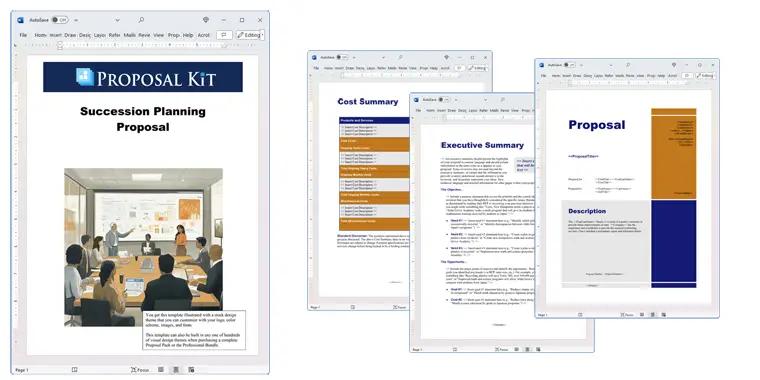How to write your Succession Planning Proposal
We include this 22 page layout with every Proposal Pack. If you want this template to have a different visual design theme than the one illustrated here, purchase any Proposal Pack design and create this template using the purchased design theme. This template is included in every Proposal Pack. If you get a Proposal Pack or the Professional, you can also make any variation of this template with different chapters to suit your needs.
We typically include more chapters in the templates than most people will need to give everyone more variety in the chapters they may need. You can trim down a long template by removing pages you do not need or combining multiple chapter topics into one page.
 DOWNLOADABLE, ONE-TIME COST, NO SUBSCRIPTION FEES
DOWNLOADABLE, ONE-TIME COST, NO SUBSCRIPTION FEESYou can also create countless variations of this document to suit your needs using the included library of 2200+ chapters if ordering a Proposal Pack or Professional.
 What Our Clients Say
What Our Clients SayThese proposals have helped to simplify the workflow in our company, they are also easy to use and affordable for any business."
POPex Limited
Related Article
Related Video
Related Templates
- Business Growth Services Proposal
- Strategic Business Map
- Strategic Plan
- Growing Company Globally Proposal
- Human Resources Strategic Planning Proposal
- Business Continuity Services Proposal
- Business Strategy Change and Implementation Proposal
- Business Management Proposal
- Business Development Proposal
- Strategic Business Plan
- Business Coach Mentoring Services Proposal
- Executive Leadership Coaching Services Proposal
- Leadership Development Program Proposal
- Business Plan to Restart Shuttered Business
- Business Continuity During Labor Shortages Proposal Template
- Due Diligence Project Proposal
- Strategic Plan for Mobilization and Deployment of Project
- Business Model Change Planning Rolling Shutdowns Proposal
- Organizational and Managerial Structure Report
- Technology Strategy Analysis
What's the best way to write your succession planning proposal?
Writing a succession proposal can be a challenging task, but with the Proposal Kit template and software package, it becomes a streamlined and efficient process. The Proposal Kit is a proven solution that not only guides you through the proposal creation but also incorporates a line-item quoting database system, enabling accurate cost summaries, quotes, estimates, budgets, and more.
Do you need to write a proposal for succession planning within your organization? If so, the Proposal Kit is designed for you.
What Types of Projects Are Succession Planning Proposal Written For?
Succession proposals are important for various internal projects within an organization. They address key issues related to business continuity, talent acquisition, and accountability for critical roles. Here are examples of projects where such proposals are written:
- Developing a leadership transition strategy
- Assessing current talent gaps
- Planning for the retirement of senior executives
- Identifying and grooming potential successors
- Establishing a mentorship program for emerging leaders
- Creating a contingency plan for unexpected departures
- Aligning talent strategies with business goals
- Implementing a company-wide training program
- Recruiting for key positions
- Creating a communications plan for stakeholders
- Evaluating internal candidates for advancement
- Designing a diversity and inclusion succession strategy
- Planning for business continuity during leadership changes
- Establishing performance metrics for key roles
- Developing a roadmap for organizational growth
- Conducting risk assessments related to succession
- Analyzing workforce demographics
- Setting up accountability frameworks
- Formulating recommendations for board approval
- Structuring the organizational hierarchy
Chapters this template is built with
While there's no one-size-fits-all premade template for every situation, Proposal Kit's software allows you to create customized variations of proposals that suit your specific needs. Here's a starting point of chapters that can be tailored using Proposal Kit's extensive content library of thousands of chapter templates:
Cover Letter
The Cover Letter serves as the introduction to your proposal, outlining the purpose and highlighting the importance of succession planning for the organization's future stability. It sets the stage for the proposal by emphasizing the critical need for a seamless transition in leadership, reassuring stakeholders of the proactive measures being taken.
Executive Summary
Provide a concise overview of the entire proposal, summarizing key points like the objectives, anticipated outcomes, and major steps involved in the succession planning process. This section distills the essence of the proposal, enabling decision-makers to quickly grasp the proposal's significance and expected impact.
Cost Summary
Detail the financial topics of your plan, including projected costs for recruiting, training, and any additional resources required, ensuring transparency and accuracy. This section helps stakeholders understand the investment needed and its justification, aligning financial expectations with organizational goals.
Needs Assessment
Identify the current and future needs of the organization, focusing on gaps in talent and leadership that the succession proposal aims to address. By conducting a thorough needs assessment, the proposal identifies critical areas requiring attention, ensuring that the organization is prepared for future challenges.
Communications Plan
Explain how the changes and initiatives will be communicated internally and externally, ensuring all stakeholders are informed and on board. A robust communications plan ensures transparency and builds trust, facilitating smoother transitions and stakeholder buy-in.
Transition Plan
Outline the steps and timeline for transitioning responsibilities and roles, minimizing disruptions, and ensuring continuity. This section provides a roadmap for change, detailing who will take over what roles and when thereby reducing uncertainty and maintaining operational stability.
Recruiting
Discuss the strategies for attracting and retaining top talent for critical positions, which is important for executing a successful succession plan. The recruitment strategies outlined here ensure the organization can fill important roles with qualified individuals who align with its future vision.
Succession Planning
Detail the specific succession strategies, including identifying potential candidates and pathways for development. This section focuses on the long-term approach to nurturing talent, ensuring there is a pipeline of qualified leaders ready to step into key roles.
Responsibilities
Define the roles and responsibilities of team members involved in the succession planning effort, ensuring accountability and clarity. By clearly delineating responsibilities, the proposal ensures all involved parties understand their roles, facilitating effective collaboration and execution.
Contingencies
Prepare for unforeseen circumstances by outlining contingency plans and preserving organizational stability amidst unexpected changes. This chapter safeguards the organization against potential disruptions, maintaining continuity even in the face of unexpected departures or changes.
Candidates
Present profiles of internal and external candidates considered for succession, evaluating their qualifications and potential fit. By showcasing detailed candidate profiles, the proposal highlights the organization's commitment to selecting the best possible leaders.
Accountability
Establish mechanisms for monitoring and evaluating the success of the succession planning efforts, ensuring goals are met. This section underscores the importance of accountability by setting benchmarks and metrics to assess the effectiveness of the succession plan.
Recommendations
Provide well-reasoned recommendations for moving forward with the plan, backed by data and analysis. Recommendations offer actionable insights, guiding decision-makers on the best course of action to secure the organization's future leadership needs.
Company History
Offer context by summarizing the company's history and previous succession efforts, highlighting lessons learned. This section provides a backdrop against which the current succession proposal is set, using past experiences to inform future strategies.
Company Operations
Describe the current state of company operations and how succession planning will align with operational goals. By linking succession planning with operational objectives, the proposal ensures that leadership transitions support and enhance the company's mission and performance.
Talent
Discuss the current talent pool and future talent needs, emphasizing the importance of developing and retaining skilled individuals. This chapter highlights the organization's focus on building a strong workforce capable of sustaining long-term success and innovation.
Key Positions
Identify the key positions within the organization that are critical to its success and require succession planning. By focusing on these roles, the proposal ensures resources are targeted where they will have the greatest impact, safeguarding the organization's core functions.
Organizational Structure
Illustrate the current organizational structure and proposed changes, facilitating an understanding of the impact of the succession plan. This section provides a visual representation of how succession planning will alter or reinforce the organizational hierarchy, aiding in alignment.
Leadership
Highlight the leadership qualities needed for future success and how the plan addresses leadership development. This chapter outlines the attributes important for driving the organization forward, ensuring the succession plan cultivates leaders who embody these qualities.
Use cases for this template
Strategizing for Seamless Leadership Transitions
The Challenge
InnovateTech was at the moment where they needed to address the issue of succession planning. With several senior executives on the edge of retirement, the company faced the formidable challenge of ensuring leadership continuity. The absence of a structured succession plan posed a risk to its long-term stability and growth. Alex, a key member of the HR team, was tasked with developing a strategy to transition these roles smoothly and without disrupting the company's operations.
The Solution
Faced with this critical task, Alex decided to use a Proposal Kit to create a comprehensive succession proposal. The solution came with a treasure trove of customizable templates and an integrated quoting system, which Alex found invaluable for outlining the necessary costs, strategies, and potential successors. The Proposal Kit's resources allowed Alex to organize information and develop a clear, actionable plan.
The Implementation
Using the extensive features of Proposal Kit, Alex created a detailed proposal that included identified successor candidates, structured training and development programs, and clear timelines for role transitions. The incorporation of AI writing tools further enhanced the proposal, allowing Alex to refine content by generating precise and relevant text sections that aligned with InnovateTech's goals.
The Outcome
The well-structured succession plan was executed without a hitch. InnovateTech managed the leadership transitions smoothly, with new leaders stepping into their roles seamlessly. The company experienced minimal disruption, maintaining its growth trajectory while ensuring organizational stability and morale. Alex's proactive use of the Proposal Kit proved in this success story.
Thriving Under Pressure with Rapid Proposal Development
The Challenge
At FutureCorp, the pressure was mounting. Jamie, entrusted with the task of writing a comprehensive succession plan, faced a deadline. A detailed proposal was required in just a few days, placing Jamie under pressure to deliver a thorough and effective plan without sacrificing quality or detail.
The Solution
To tackle this challenge head-on, Jamie turned to Proposal Kit. The pre-designed templates offered by Proposal Kit were a lifesaver, as they provided a structure that could be quickly customized. By integrating AI writing tools, Jamie was able to efficiently generate tailored content that accurately reflected FutureCorp's unique needs and goals.
The Implementation
Armed with the Proposal Kit's structured templates and enhanced by AI assistance, Jamie developed a comprehensive proposal. The AI tools analyzed FutureCorp's website, helping write precise sections like the company history and key positions. This streamlined approach allowed Jamie to focus on fine-tuning the proposal's topics and ensuring alignment with company objectives.
The Outcome
Jamie delivered a polished and professional succession plan within a tight deadline, exceeding stakeholder expectations. FutureCorp's leadership approved the plan, ensuring a smooth transition in key roles and continuity in leadership. Jamie's adept use of the Proposal Kit and AI tools showcased the potential for rapid yet effective proposal development under pressure.
Efficient Proposal Writing for Non-Profit Succession Planning
The Challenge
GreenFuture, a non-profit organization, faced the critical task of preparing a Request for Proposal (RFP) to attract consulting firms capable of developing their succession plan. With limited resources and time, Director Casey needed to write a professional RFP that clearly articulated the non-profit's needs and expectations, ensuring they could engage the right partner for their succession planning initiative.
The Solution
Casey embraced the Proposal Kit as the foundation for creating a detailed and compelling RFP. The templates provided a robust framework that ensured every critical topic of the succession planning requirement was covered. Proposal Kit's ease of customization allowed Casey to tailor the document to highlight GreenFuture's specific needs and expectations.
The Implementation
Using Proposal Kit's comprehensive resources, Casey created a well-structured RFP that communicated the organization's objectives and constraints. The document attracted several qualified consulting firms, each with the expertise needed to guide GreenFuture through the succession planning process. Proposal Kit's templates ensured that the RFP was both professional and thorough.
The Outcome
GreenFuture successfully partnered with a consulting firm experienced in non-profit succession planning. Together, they developed a strong and sustainable succession strategy that bolstered GreenFuture's leadership capacity and positioned the organization for continued success. Casey's use of the Proposal Kit played a role in achieving this successful partnership and enhancing the organization's future leadership potential.
Conclusions and Recommendations
Writing a succession proposal need not be a complex task. With Proposal Kit's extensive library of templates and integrated software features, creating a detailed and effective proposal becomes manageable. From leadership transition strategies to organizational structure, Proposal Kit offers the tools needed to address every topic of succession planning, ensuring organizations can plan for the future with confidence and clarity.
Also Known As
This template may also be referred to in different ways or be used in more specialized situations, such as:
- Succession Strategy Document
- Leadership Continuity Plan
- Future Leadership Proposal
- Key Position Planning Template
- Talent Development Proposal
- Executive Transition Plan
- Continuity Strategy Document
- Organizational Succession Proposal
- Successor Development Plan
- Next Generation Leadership Plan
Abstract
 Effective succession planning is important for ensuring an organization's long-term success and ability to adapt to business challenges. By identifying key positions, developing robust succession planning strategies, and anticipating future leadership roles, organizations proactively prepare for inevitable changes when key employees depart or senior leaders retire. A strong succession planning model centers on identifying high-potential employees, assessing skills gaps, and establishing clear pathways for career growth and leadership development opportunities. The process not only helps to preserve institutional knowledge and sustain business operations but also builds a competitive edge by nurturing internal talent and preparing future leaders for executive positions.
Effective succession planning is important for ensuring an organization's long-term success and ability to adapt to business challenges. By identifying key positions, developing robust succession planning strategies, and anticipating future leadership roles, organizations proactively prepare for inevitable changes when key employees depart or senior leaders retire. A strong succession planning model centers on identifying high-potential employees, assessing skills gaps, and establishing clear pathways for career growth and leadership development opportunities. The process not only helps to preserve institutional knowledge and sustain business operations but also builds a competitive edge by nurturing internal talent and preparing future leaders for executive positions.
Successful succession planning practices involve a thorough assessment of current skills, talent identification, and the alignment of succession planning goals with the organization's goals. Leadership development programs, mentorship opportunities, executive coaching, and stretch assignments are important components that help develop leaders and strengthen leadership competencies. Regular feedback, performance reviews, and job rotations provide ongoing employee development and expose potential leaders to cross-functional experiences, preparing them to assume new responsibilities in vital positions.
Organizations must regularly review and update succession plans, involve key stakeholders such as senior management, board members, and a succession planning committee, and employ a proactive approach to identify potential successors for critical roles. By embracing diversity and offering tailored development programs, organizations maximize the growth potential of high-performing individuals and ensure a continuous pipeline of key talent. Succession planning effectiveness is achieved through data-driven decisions, open communication, and a culture of continuous improvement.
 A formal succession plan, supported by a clear communication strategy and action plans, serves as a safety net for emergency succession situations, emergency succession plans, and knowledge transfer when key roles are left vacant. By investing in leadership development best practices and using tools such as a succession planning template, organizations ensure that leadership teams are equipped to meet future business needs. Ultimately, succession planning is not a one-time event but an ongoing process that supports sustained growth, smooth transitions, and the achievement of the organization's success and objectives.
A formal succession plan, supported by a clear communication strategy and action plans, serves as a safety net for emergency succession situations, emergency succession plans, and knowledge transfer when key roles are left vacant. By investing in leadership development best practices and using tools such as a succession planning template, organizations ensure that leadership teams are equipped to meet future business needs. Ultimately, succession planning is not a one-time event but an ongoing process that supports sustained growth, smooth transitions, and the achievement of the organization's success and objectives.
A well-written succession plan is crucial for organizations aiming to identify key positions and ensure that talented individuals are ready to fill leadership positions as business needs change. Many organizations recognize succession planning as a vital role in preserving institutional knowledge and maintaining momentum when senior leadership or senior members retire or transition. By integrating succession planning best practices, such as talent assessment, identifying key roles and high potential employees, and offering targeted training and development paths, organizations empower future leaders to gain the leadership skills and specific skills required for senior positions and higher-level roles.
Establishing a succession plan supports the organization's long-term success by aligning leadership development programs with the company's future and business strategy. For example, a succession plan example may include a four-step process: identifying internal candidates and succession candidates, evaluating their competencies required for important roles, providing challenging assignments and mentoring, and offering regular feedback and learning opportunities to prepare successors for future roles. This approach ensures a continuous pipeline of key leaders and top performers who possess the right skills and emotional intelligence necessary for promotion and internal promotions.
 Proposal Kit serves as a great starting point for HR leaders, managers, and business leaders who are responsible for creating actionable succession plans. Its complex document assembly and extensive libraries of downloadable templates help organizations clearly outline their evaluation process, training plans, and communication skills needed to ensure smooth transitions and meet the organization's goals. The tool enables regular check-ins and regular reviews of progress, helping organizations continuously monitor, track, and adjust succession planning strategies as market conditions, company culture, and growth opportunities evolve.
Proposal Kit serves as a great starting point for HR leaders, managers, and business leaders who are responsible for creating actionable succession plans. Its complex document assembly and extensive libraries of downloadable templates help organizations clearly outline their evaluation process, training plans, and communication skills needed to ensure smooth transitions and meet the organization's goals. The tool enables regular check-ins and regular reviews of progress, helping organizations continuously monitor, track, and adjust succession planning strategies as market conditions, company culture, and growth opportunities evolve.
Succession planning is important for managing expectations and engagement among current leaders, peers, and departments, as well as for fostering a learning culture where employees actively participate in their own career aspirations and continuous development. By embracing diversity and encouraging different departments to collaborate, organizations gain fresh perspectives and maximize the future potential of high-performing employees and high-potential individuals. Succession planning effectiveness is further enhanced by providing exposure to day-to-day operations, cross-functional relationships, and leadership requirements, which builds a strong talent pipeline and ensures that the right person is ready to take ownership of vital positions such as the CEO role.
As organizations start planning for succession, they benefit from valuable insights that allow them to determine the best talent, identify leadership qualities and individual strengths, and make informed decisions about hiring or external recruitment when suitable replacements cannot be found internally. Succession planning goals support long-term goals, drive innovation, and safeguard against the risks that arise when key employees depart for extended periods. This is why HR plays an important role in guiding and supporting succession planning practices, helping organizations succeed and meet their goals, investors' expectations, and the demands of a changing business environment.
 Succession planning effectiveness depends on a clear understanding of the organization's goals and the proactive identification of future leaders who possess the critical skills and key competencies required for success. Many organizations find that starting early and involving senior managers in the process ensures readiness and helps prevent disruptions when leadership changes occur, including the appointment of a new CEO. Regularly assessing current performance and conducting talent reviews allows HR leaders to identify high-potential employees and internal candidates who are prepared to step into important roles or explore new roles as part of their career progression.
Succession planning effectiveness depends on a clear understanding of the organization's goals and the proactive identification of future leaders who possess the critical skills and key competencies required for success. Many organizations find that starting early and involving senior managers in the process ensures readiness and helps prevent disruptions when leadership changes occur, including the appointment of a new CEO. Regularly assessing current performance and conducting talent reviews allows HR leaders to identify high-potential employees and internal candidates who are prepared to step into important roles or explore new roles as part of their career progression.
It makes sense for organizations to invest in robust succession planning practices not only to reduce the risk of key leadership gaps but also to foster continuous learning and motivation among employees. By embracing diversity and considering multiple candidates from different backgrounds and departments, companies gain the advantage of fresh perspectives and broader skills and knowledge across the leadership pipeline. This helps ensure that the right leaders are chosen to guide the company's future and deliver long-term success.
A successful plan helps organizations stay ahead of market changes and other external factors that might impact the business. HR plays a vital role in providing guidance, goal setting, and mentoring to ensure that each identified individual receives targeted development aligned with the required competencies for their next role. Through regular feedback, tracking milestones, and supporting employees' career aspirations, organizations make certain that high-potential individuals reach their full potential and are equipped for higher-level responsibilities.
 Identifying and nurturing high-potential employees and internal candidates strengthens organizational resilience, increases engagement, and aligns leadership transitions with the organization's success. The first step in effective succession planning is a thorough evaluation of current skills and identifying gaps, followed by structured development programs and exposure to challenging experiences. This approach not only prepares future leaders for the demands of senior positions but also provides a safety net in case of unforeseen departures so the organization does not fail or lose momentum at critical times.
Identifying and nurturing high-potential employees and internal candidates strengthens organizational resilience, increases engagement, and aligns leadership transitions with the organization's success. The first step in effective succession planning is a thorough evaluation of current skills and identifying gaps, followed by structured development programs and exposure to challenging experiences. This approach not only prepares future leaders for the demands of senior positions but also provides a safety net in case of unforeseen departures so the organization does not fail or lose momentum at critical times.
Ultimately, succession planning is significant because it ensures stability, supports the achievement of objectives, and provides the benefits of long-term growth for the organization and its stakeholders. By continually investing in and refining succession strategies, organizations are better prepared to meet the milestones that matter and maintain the continuity necessary for ongoing success.
Frequently Asked Questions
What is the main purpose of writing a succession proposal?
The primary purpose of writing a succession proposal is to ensure business continuity by systematically identifying and preparing qualified individuals to fill key leadership roles within the organization. This document outlines strategies and processes to manage leadership transitions, mitigate potential disruptions to operations, and maintain organizational stability.
How can Proposal Kit specifically aid in creating a comprehensive succession proposal?
Proposal Kit provides an extensive library of customizable templates that guide you through the proposal writing process. It includes specific chapter templates focused on various topics of succession planning, such as leadership, responsibilities, and talent management. This tailored approach ensures that all crucial topics of succession planning are thoroughly addressed in your proposal.
What financial considerations should be included in a succession proposal, and how does Proposal Kit assist with them?
Financial considerations in a succession proposal typically involve estimating costs related to recruiting, training, and development programs. Proposal Kit assists by offering a line-item quoting database system that enables the creation of detailed cost summaries, estimates, and budgets, ensuring financial transparency and helping stakeholders understand the investment required for effective succession planning.
Is the Proposal Kit suitable for small businesses or only larger organizations when preparing a succession proposal?
Proposal Kit is designed to be flexible and scalable, making it suitable for organizations of all sizes, from small businesses to large enterprises. Its wide range of templates and customization options allows any organization to create a succession proposal that is tailored to their specific needs and resource constraints, ensuring that they can plan for leadership continuity.
How quickly can a succession proposal be completed using the Proposal Kit, especially under tight deadlines?
Proposal Kit's user-friendly interface and extensive collection of pre-designed templates enable quick preparation of a succession proposal, even under tight deadlines. By streamlining the writing process and providing structured content frameworks, Proposal Kit helps users produce a polished and comprehensive proposal efficiently, allowing organizations to respond swiftly to their succession planning needs.
20% Off Discount
![]() Add To Cart This Word Template
Add To Cart This Word Template
 Add To Cart Proposal Pack for Any Business
Add To Cart Proposal Pack for Any Business
 Add To Cart Proposal Kit Professional
Add To Cart Proposal Kit Professional
 4.7 stars, based on 849 reviews
4.7 stars, based on 849 reviewsProposal Kit chapters used in this template
Cover Letter, Title Page, Table of Contents, Executive Summary, Needs Assessment, Succession Planning, Contingencies, Transition Plan, Communications Plan, Organizational Structure, Leadership, Key Positions, Candidates, Recruiting, Talent, Responsibilities, Accountability, Cost Summary, Recommendations, Company History, Company Operations, Back Page
Line Item Automated Chapters
If you purchase a Proposal Pack or the Professional Bundle, these proposal pages are generated using an automated line-item database in the included Wizard software.
Cost Summary
You use this proposal for
- General business proposal
- Non-technical proposal
- Project pitch proposal
- Resume and employment proposal
- Internal company proposal
How to create this template with Proposal Pack Wizard
You can create this document using any of the logo-designed Proposal Packs. Pick any Proposal Pack with a logo design theme you like best; they will all work equally well. The Proposal Pack for Any Business is the pack with no extra added logos or colors - designed to be used plain or for you to customize with your logos and graphics.
The Proposal Pack design theme you purchase will determine the visual look of this template. The screenshot above only shows the plain generic design theme.
We include a library of chapters to be assembled based on your needs. All proposals are different and have different needs and goals. We designed Proposal Pack so you can customize the documents to suit your needs.
You will best create this document using the Proposal Pack Wizard - Expert Edition software to select this template and build it in the Proposal Pack logo design theme of your choice along with any desired customizations (such as adding additional chapters, removing unneeded chapters, changing the order of chapters, and importing your company logo). This template outlines a proposal for the described situation. Each user is responsible for typing in the actual content of the provided pages with their information to complete the proposal. Suggestions in the abstract may include features in higher-end packages and are facilitated by the selection of chapter templates to support the narrative of each proposal, which help guide the user in filling in the details.
The Wizard software's AI Writer will write the content of the pages of the template based on details provided for your company, client, project, financial details and other writing instructions. This will provide a personalized version of the template completely written and ready to edit.
Once finished, the AI Writer's Word-to-PowerPoint converter can transform your proposal, business plan, or other business documents into a PowerPoint slideshow. Save time and effort by letting the AI analyze every chapter to condense its content into talking points, visually matching the document, and providing a consistent package of presentation material with the click of a button.
You create this template using the Wizard software with an entire Proposal Pack library and software. We include the Expert Edition of the software in the Proposal Kit Professional. Microsoft Word for Windows is required to use the customizing software. You can also edit Word document templates in other office software such as Word for Mac. We will assist Mac users in assembling complex templates for their first project if they do not have the required platform to run the Wizard software.
How to Build Templates Featured on Proposal Kit Website
Many people find the Proposal Kit website after searching for a specific proposal. Once you've purchased and installed the software, how do you build that template you found in the first place? This video shows you how to build any proposal you see on the Proposal Kit website.
 Ian Lauder has been helping businesses write their proposals and contracts for two decades. Ian is the owner and founder of Proposal Kit, one of the original sources of business proposal and contract software products started in 1997.
Ian Lauder has been helping businesses write their proposals and contracts for two decades. Ian is the owner and founder of Proposal Kit, one of the original sources of business proposal and contract software products started in 1997.By Ian Lauder
 Published by Proposal Kit, Inc.
Published by Proposal Kit, Inc.


 Cart
Cart
 Get 20% off ordering today:
Get 20% off ordering today: 


 Facebook
Facebook YouTube
YouTube Bluesky
Bluesky Search Site
Search Site